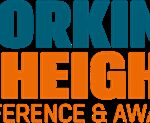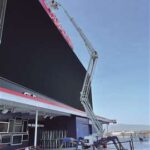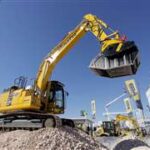Aerial work platforms (AWPs) are indispensable tools in the modern industrial world, offering innovative solutions for tasks that require elevated access. From towering skyscrapers to challenging terrains, AWPs have become essential for workers who need to perform tasks at height, safely and efficiently. These versatile machines have revolutionized the way we approach maintenance, construction, and emergency services, transforming jobs that were once dangerous and time-consuming into more manageable and secure operations.
Understanding the Mechanics of Aerial Work Platforms
An aerial work platform is a mechanical device designed to lift workers, tools, and materials to heights that would otherwise be inaccessible or dangerous to reach. Unlike traditional methods such as scaffolding or ladders, AWPs provide a stable and controlled environment for workers to perform tasks in high places. These machines are typically classified based on their lift mechanism, mobility, and specific use cases.
-
Boom Lifts: Versatility at Its Best
Boom lifts, also known as cherry pickers, are among the most well-known types of AWPs. Originally developed to help harvest cherries, boom lifts have evolved into multi-functional machines capable of reaching both vertical and horizontal heights. The extendable boom arm, which can be articulated or telescoping, allows operators to access hard-to-reach areas, whether it’s a high-rise building or a narrow alleyway. This flexibility makes boom lifts a popular choice in industries such as construction, maintenance, and even film production.The cherry picker is known for its ability to adjust its height and reach, making it an excellent choice for tasks that require precision. Whether it’s installing signs on tall buildings or rescuing people from high places, boom lifts are designed to provide operators with the ability to move freely and safely at height. Modern versions of boom lifts often come equipped with additional features such as electrical outlets, hydraulic lifts, and even platforms for transporting heavy materials, further expanding their utility.
-
Scissor Lifts: Stability and Strength
While boom lifts offer flexibility in movement, scissor lifts excel in providing a stable platform for vertical work. This type of lift uses a scissor mechanism, with a series of crisscrossed supports that extend and retract to raise and lower the platform. Unlike boom lifts, scissor lifts are limited to vertical movement, but their design ensures that they can carry heavier loads and provide a more stable platform for tasks that require lifting significant weight.Scissor lifts are often used for indoor projects, especially in environments with limited space, such as warehouses, factories, or shopping malls. These lifts are especially useful for maintenance tasks like replacing lights, cleaning windows, or performing repairs on building facades. Due to their compact size, they are also ideal for working in tight or narrow spaces where other types of lifts might not fit.
-
Spider Lifts: Ideal for Rough Terrain
Some AWPs are designed with special features that allow them to operate in more challenging environments. Spider lifts, for example, are known for their unique appearance—resembling a spider when their legs unfold to stabilize the lift. These lifts are often used in rough terrains or areas with unstable ground, where traditional lifts may struggle to operate. The spider legs provide extra support and stability, making them ideal for construction sites, forestry work, and other environments where uneven ground is common.Spider lifts can be used both indoors and outdoors, and their ability to stabilize on rough terrain makes them particularly useful for jobs that require mobility in areas like hills, slopes, or construction zones with debris. Their versatility and ability to operate on challenging surfaces make spider lifts a popular choice in industries such as arboriculture, where workers need to access trees in difficult locations.
Aerial Work Platforms in Action: Expanding Their Reach
AWPs are used across a wide range of industries and applications, offering a safer, faster, and more efficient way to work at height. While they are primarily associated with construction and maintenance, their uses extend far beyond these fields. From emergency services to telecommunications, AWPs play a vital role in ensuring the safety and efficiency of workers who operate in high-risk environments.
-
Construction: Building the Future Safely
The construction industry is one of the largest users of AWPs. These platforms provide workers with quick and safe access to heights, which is essential for tasks such as installing windows, repairing roofs, or working on tall structures. In the past, construction workers relied on ladders or scaffolding to access these areas, but AWPs have replaced these outdated methods with a more efficient and safer solution.Boom lifts and scissor lifts are commonly used on construction sites, offering flexibility and stability for workers who need to reach different parts of a building. With their ability to carry materials, tools, and workers to high points, AWPs make it easier to complete tasks that would otherwise require complex scaffolding or risky ladder work.
-
Emergency Services: Saving Lives from Above
AWPs have also become crucial in emergency response situations, particularly for firefighters and rescue teams. Fire departments use specialized aerial work platforms mounted on fire trucks to access high-rise buildings and rescue people trapped on upper floors. These lifts provide a safe, elevated platform for firefighters to reach windows, balconies, or rooftops, allowing them to save lives quickly and efficiently.In addition to their use in firefighting, AWPs are also used by emergency responders for rescue operations in difficult or dangerous locations. Whether it’s rescuing people from cliffs, retrieving them from collapsed structures, or providing access to hazardous areas, AWPs offer the stability and flexibility needed to perform critical tasks under pressure.
-
Telecommunications and Power Lines: Reaching the Unreachable
Another field that heavily relies on AWPs is telecommunications. Workers in this industry often need to access communication towers or electrical lines that are situated at significant heights. AWPs allow these workers to safely reach the required elevation without the risk of falling or encountering other dangers associated with traditional climbing methods.Similarly, AWPs are essential in the power and utilities sector, where workers need to access power lines, streetlights, and electrical towers. These platforms enable workers to perform repairs, inspections, and installations with ease, reducing downtime and ensuring that essential services remain operational.
Innovations in Safety and Technology: The Future of AWPs
As with any machinery, safety is a top priority when it comes to aerial work platforms. Manufacturers are continuously improving the safety features of AWPs to ensure that they can be used effectively and securely in a variety of environments.
-
Smart Sensors and Stability Control
Modern AWPs come equipped with smart sensors that monitor the platform’s stability and weight distribution. These sensors can automatically adjust the lift’s operation, preventing it from tipping over if the weight becomes unbalanced or if the lift is placed on an unstable surface. Additionally, many AWPs are now designed with advanced stability control systems that prevent accidents and ensure that workers are always operating in a secure environment. -
Remote Control and Monitoring
Remote control technology has become a key feature of many AWPs, allowing operators to control the lift from a distance. This capability is particularly useful in hazardous situations, where the operator may need to stay at a safe distance from potential dangers. Remote monitoring systems also allow fleet managers to track the performance of AWPs in real-time, ensuring that the machines are operating efficiently and safely. -
Eco-Friendly Models
In response to growing environmental concerns, many manufacturers are now producing electric-powered AWPs. These models are not only quieter and more environmentally friendly but also allow operators to work indoors without the worry of exhaust emissions. Hybrid models, which combine both electric and gasoline power, offer a flexible solution for both indoor and outdoor applications, making them perfect for a variety of job sites.
The Road Ahead: AWP Technology and Its Expanding Role
Looking forward, the role of AWPs is only set to expand as technology continues to evolve. As industries across the globe recognize the value of these versatile machines, the demand for new, innovative solutions will increase. With smarter, more efficient, and safer machines on the horizon, AWPs will continue to transform the way we work at height, providing a safer, more productive future for workers around the world.
In the coming years, we can expect to see further advancements in AWP technology, from autonomous systems to more eco-friendly options, making these platforms even more integral to industries like construction, maintenance, emergency services, and beyond.




